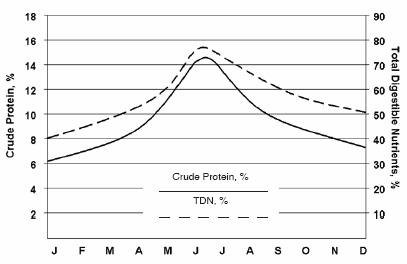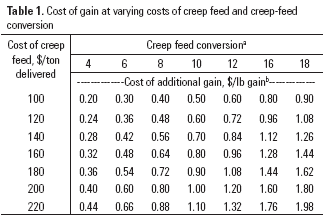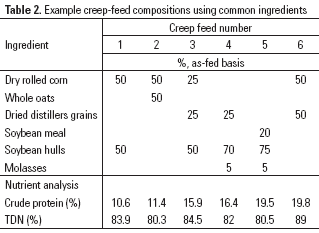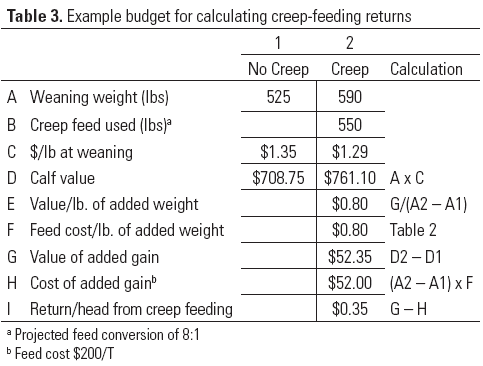



Creep Feeding Beef Calves
Creep feeding is a way to provide nursing calves with supplemental nutrients with the use of a gate that restricts the access of cows to the feeding area, says Eric Mousel, Extension range livestock specialist; Cody Wright, Extension beef specialist; Julie A. Walker, Extension beef specialist; Heather Gessner, Extension farm management educator.
The type of creep feeds available vary from grain-based feeds that primarily supplement energy, to limit-fed high-protein feeds, to “green creeps,” which are high-quality pastures grown for the sole purpose of grazing by nursing calves. Creep feeding for the purpose of increasing weaning weight alone may not be profitable; therefore, the decision to creep feed calves should be based on the analysis of expected increases in performance and income compared to the cost of feed.
Nutrient requirements
The energy and protein requirements of nursing calves are poorly defined. Previous researchers have utilised creep feeding to help correct nutrient deficiencies in nursing calves. However, the first limiting nutrient is variable and likely depends on the forage species and timing within the grazing season.
Calves that are less than 90 days of age receive the majority of their nutrient intake from milk. After 90 days, the calves consume an increasing proportion of their nutrient intake from forage. High-quality pasture is generally the most economical source of nutrients during this period; however, the increase in nutrient requirements for calves from spring-calving herds in the northern Great Plains comes at a time when the nutrient density of pastures is rapidly declining (Figure 1). When the amount of high-quality forage is limited or unavailable, supplemental creep feeding should be evaluated as an alternative to maintain calf performance.
EFFICIENCY AND COST OF GAIN

The most critical consideration for a creep feeding program is the cost of additional gain. The highest economic returns from creep feeding typically occur when: (1) forage is too mature for efficient utilisation, (2) forage quantity is limited due to drought or overgrazing, or (3) calves are nursing poor-milking cows or heifers. There are genetic limitations on the rate of gain calves can achieve; therefore, when milk and high-quality pasture are abundant, the cost of additional gain from creep feeding will likely be quite high.
The type of creep feed greatly influences the conversion of feed to added gain. Research has shown that creep feed conversion can range from 4:1 to 18:1 pounds of feed to a pound of calf gain. However, feed conversions are typically around 4:1 for a limited protein-based feed and 8:1 for an energy-based feed. Table 1 shows the cost of gain at various feed costs and feed conversion rates.
OTHER CONSIDERATIONS

b Cost of additional gain = $/lb creep feed consumed × (lb creep feed consumed/lb added gain from creep)
In addition to improved feed efficiency, several factors should be considered when determining the economic efficiency and feasibility of creep feeding. Creep feeding will not only increase calf growth rate but also may provide a smoother transition from pasture to a grain-based diet.
In most cases, younger calves will meet nutrient requirements by nursing to capacity before moving to other feeds. Therefore, pressure on lactating cows is not significantly reduced as a result of creep feeding, and little if any grass will be saved. However, as calves continue to mature, they will generally consume increasing amounts of forage, potentially as much as one per cent of their body weight (dry matter basis). Creep feeding, then, can lead to a substantial reduction in the amount of forage consumed by the calves.
Starting calves on creep feed
Occasionally, getting calves started on creep feed can be a challenge, especially when cows are milking well and pastures are in good condition. Typically, feeding cows small amounts of ground feed a few days prior to starting creep feeding will help calves learn to consume creep. Baiting cows to the creep area with feed also will help expose calves to creep feed. Including highly palatable feeds such as molasses, distillers grains, soybean hulls, or field peas in the creep feed will also help to attract calves to the feeder.
Creep feeders should be placed in areas that cows visit regularly. These sites should be shaded and open to prevailing winds, have water or salt and mineral in close proximity, and the area should be large enough that whole herd can congregate. If the herd is in a relative large pasture, more than one creep site may be necessary.
Post-weaning calf performance and carcass traits
The impact of creep feeding on post-weaning calf performance likely depends on how the weaned calves are handled. Calves that will be roughed through the winter or run as stocker cattle may experience reduced performance if they are too fleshy at weaning time. Creep feeding is more advantageous for calves that will be fed out immediately after weaning. The creep feed will help familiarise the cattle with dry feeds, and research has shown that this results in greater feed intake and reduced stress during and after weaning. Creep feeding calves that will be sold at or shortly after weaning may be beneficial. However, care should be taken to avoid getting the calves too fleshy and exposing them to discounts at the market.
The potential for increased marbling development as a result of creep feeding may also be beneficial. Marbling is now known to develop far earlier in life than previously thought. As such, calves nursing poor-milking cows or on pastures with limited forage quality or quantity may not be able to consume enough calories to support marbling development. Under these circumstances, creep feeding allows for calves to reach their genetic potential for marbling. Researchers have demonstrated this response in calves that have been fed creep feed for at least 80 days. However, in order to retain the increased marbling, calves should be placed on a grain based diet after weaning.
Effect of creep feeding replacement heifers
Creep feeding can negatively influence replacement heifer performance by depressing future milk production and lifetime productivity. Excessive nutrient supplementation can result in udder fat deposition during the prepubertal mammary growth phase, which starts as early as 3 months of age. Producers retaining replacements are forced to decide between potential advantages in greater weaning weights from creep feeding or optimising future milk production. Sorting replacements prior to weaning is a potential option, but this practice requires selection early in development.
Choosing high-protein feeds may prevent the negative effects of creep feeding on future milk production; however, unless the objective is to increase weights or body condition for a sale, creep feeding is generally unnecessary for replacement heifers. Research has indicated that heifers should reach 65 per cent of their mature weight by the beginning of the breeding season. Under most circumstances, it is quite easy to achieve the necessary gain without the use of creep feed.
Using salt as a creep-feed limiter
Creep feed consumption can be limited by using salt in the creep diet at a rate of 3 to 10 per cent. Limiting creep feed intake during the last 60 to 90 days prior to weaning may have a couple of advantages:
- a moderate increase in weaning weight without excessive “fleshiness”
- improved feed conversion compared to unlimited access to feed
Starting with about three per cent salt in the ration and making adjustments to no more than 10 per cent of the diet until individual intake is around 1.5 to 3.0 lbs of feed per day is recommended. When using salt as a limiter in homemade creep feeds, meal forms probably work better than pellets, because it is easier to adjust the salt levels to maintain daily intake. One caution when using salt as an intake limiter is that it can cause additional corrosion to metal creep feeders.
Common creep-feed rations for beef calves

Many different feed ingredients can be utilised in creep feeds. Grains utilised in creep feeds should be coarsely processed for optimum utilisation by calves. However, if the price of the grains is low, the added efficiency may not be enough to cover the expense of processing the grain. Feeding whole grain may result in the lowest cost of gain. Exceptions would be barley and grain sorghum. The seed coats of these feeds are hard enough that feeding them in an unprocessed form substantially reduces their utilisation. When processing your own feedstuffs for a creep feed, be aware that excessive processing or grinding feedstuffs too fine can increase the risk for digestive disturbances.
Adding viscous compounds such as molasses or sunflower oil can reduce dust problems and improve palatability. Creep rations do not have to be complex; however, in some situations you may find that purchasing higher-quality (and priced) commercial feeds may be a better alternative for your situation.
When formulating creep diets, it is important to carefully consider the particle size and density of feed ingredients (both processed and unprocessed). Feeds that are dramatically different in these respects are likely to flow out of the feeder at different rates and are more subject to sorting by the calves. Examples of creep feed rations using common ingredients are shown in table 2.

Calculating creep-feeding returns
Although creep feeding can significantly increase weaning weight, costs associated with creep feeding can result in minimal economic benefit. Therefore, when evaluating the financial benefit of creep feeding, it is important to understand the relationship between the cost of the creep feed consumed and the value of the additional weight gained. Table 3 shows an example budget for calculating returns per head for creep feeding. A worksheet is provided below table 3 for you to use to evaluate the returns from creep feeding in your situation.

May 2010


